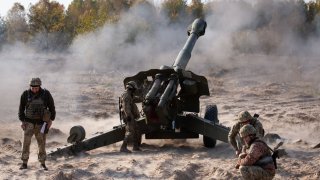Joe Biden’s Ukraine Policy is Marching Toward Catastrophe
Allowing Ukraine to use American weapons to strike targets in Russian territory increases the risk of escalation without meaningfully aiding Ukrainian capabilities.
The North Atlantic Treaty Organization (NATO) alliance is facing a significant turning point in its support for Ukraine’s defense against Russia. The Biden administration, in lockstep with several of the United States’ European allies, has approved the use of American weapons to strike targets on Russian soil around the Ukrainian city of Kharkiv.
The decision arrived months after French president Emmanuel Macron openly floated the idea of NATO troops joining the fight in Ukraine. While the White House has denied this possibility, General Charles Q. Brown Jr., the chairman of the Joint Chiefs of Staff, acknowledged the inevitability of eventually sending military trainers to expedite the preparation of freshly drafted Ukrainian troops for the front lines. Both his and Macron’s statements catapult the war into unknown territory, creating opportunities for significant escalation while contributing little to Ukraine’s ability to change realities on the battlefield.
Biden’s authorization to leverage American equipment to strike targets in Russia near Kharkiv unravels American policy going back to the beginning of the Cold War—while American military aid has been used to attack Soviet and Russian forces, it was never authorized to openly hit targets within the Soviet Union or Russia itself (with the notable exception of the American intervention in the Russian Civil War from 1918–1920). Ukraine has already proven willing to use its own long-range munitions to strike targets related to Russia’s nuclear defense posture—such as nuclear strategic bombers at Engels air base earlier in the war and a nuclear defense early-warning radar just a few weeks ago. This creates an immense risk that Moscow perceives this policy change as the first stage of a serious expansion of the conflict with the goal of collapsing the Russian state and deposing Vladimir Putin.
The prospect of alliance trainers on the ground creates a different high-risk, low-reward situation. American, French, or otherwise, trainers would be vulnerable to either deliberate or accidental strikes from Russia’s country-wide missile and drone campaign that targets Ukrainian infrastructure and military targets regularly—to say nothing of the direct risk from artillery, tanks, and infantry for trainers stationed near the front lines.
If those trainers are killed in a strike, the victim country could choose to make a case that the attack constitutes a triggering of NATO’s Article V mutual defense agreement. While allied nations could choose to reject that claim, it would create a crisis within the alliance. It could lead to either direct U.S. involvement in the war or a massive fissure in our relationship with allied nations.
Unfortunately, the risks involved do not stop there. Trainers and advisers, often drawn from special operations forces, are typically deployed close to conflict zones. Their mission is to enhance the capabilities of local forces, providing them with the skills and knowledge necessary to engage in combat effectively. However, this proximity to the front lines often blurs the lines between training and direct combat involvement.
In Ukraine, U.S. trainers will not merely be passive observers. Co-author Jason Beardsley personally participated in advising and assisting missions during his twenty-two years in the U.S. Armed Forces. They are actively involved in leading and guiding local forces, potentially finding themselves amid combat scenarios. Historical precedent from America’s advise and assist mission in Vietnam suggests that the Biden administration would be sleepwalking into another scenario where mission creep contributes to full-blown war. The distinction between advising, assisting, and training becomes indistinguishable from combat.
Rules of engagement for trainers and advisers allow for combat involvement if they come under attack. This defensive posture, while necessary for self-protection, increases the likelihood that U.S. soldiers will engage in direct combat with Russian forces. Mr. Beardsley recalls numerous instances during advise and assist operations where the line between training and combat was perilously thin. These missions were fraught with tension. At times, his role involved advising and training the local forces and making decisions about direct engagements. The constant threat of attack and the need to follow strict rules of engagement created an environment of perpetual strain and danger for both him and the local forces he supported.
These experiences underscore the risks that American trainers in Ukraine will face. The potential for direct engagement with Russian forces, whether intentional or accidental, could have far-reaching consequences. The escalation of the conflict would not only endanger the lives of U.S. personnel but also risk drawing the United States into a broader confrontation with Russia.
President Biden’s policy shifts create a situation where the administration will find it highly challenging to control escalation in a crisis. President Biden promised the American people that he would not put boots on the ground in Ukraine. Unfortunately, his current policies are slow-walking the United States into breaking those promises.
Robert Clarke is the Director of Marketing Strategy for Foreign Policy at Stand Together. His commentary on U.S. foreign policy has appeared in The American Conservative, Realist Review, and the Financial Times. Follow him on X at @ClarkeDynamics.
Jason Beardsley is the Director of Veterans’ Initiatives at Stand Together and Senior Advisor for Concerned Veterans for America. He served for twenty-two years in the United States Army and Navy. Follow him on X at @JasonRBeardsley.
Image: Home for Heroes / Shutterstock.com.

